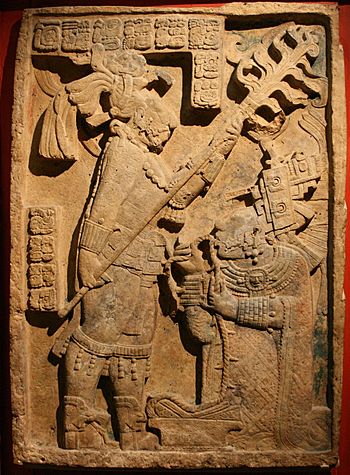Yaxchilan Lintel 24 facts for kids
Quick facts for kids Lintel 24 |
|
|---|---|

The lintel as displayed in the British Museum
|
|
| Material | Limestone |
| Created | Estimated to be 709 AD |
| Present location | British Museum, London, England |
Lintel 24 is an ancient stone carving from the Maya civilization. It was made from limestone in a place called Yaxchilan, which is now in Mexico. This carving is very old, dating back to about 723–726 AD. This time is known as the Maya Late Classic period.
The carving shows two important people: the ruler of Yaxchilan, Itzamnaaj Bahlam III, and his wife, Lady K’abal Xoc. They are taking part in a special Maya ceremony. The stone also has writing that explains what is happening. What's cool is that it even has the signature of the artist, Mo’ Chaak!
Contents
Finding and Moving Lintel 24
Lintel 24 was found with two other similar carvings, Lintels 25 and 26. They were all part of a building called Structure 23 in Yaxchilan.
In 1882, a person named Alfred Maudslay carefully cut Lintel 24 from the building's ceiling. He then sent it to Great Britain. Today, you can see it in the British Museum in London. Lintel 25 was also moved in 1883. Lintel 26 was found later in 1897 by Teobert Maler. It was moved to a museum in Mexico in 1964. The original building, Structure 23, has since fallen down.
The Carved Messages
The carving on Lintel 24 includes three main parts of text. The first part talks about King Itzamnaaj Bahlam. The second part describes Lady Xoc. The last part is special because it's the artist's signature. This shows that the artist, Mo’ Chaak, was proud of his work.
Art Style of the Lintel

Lintel 24 is made in a style called "high relief." This means the figures carved into the stone stick out a lot from the background. Lady Xoc likely asked for these carvings to be made for the doorways of Structure 23.
The lintels show the king and queen in amazing detail. You can see their fancy clothes and jewelry very clearly. Some people think these carvings are among the best examples of Maya art. We can even study how the Maya wove fabric and added pearls to their clothes by looking at these details.
Because of small differences, it seems that two or three different artists worked on these lintels. Each carving is signed, which tells us that making such art was a very important skill, not just a simple job.
The King: Itzamnaaj Bahlam III
Itzamnaaj Bahlam III was a very important leader of Yaxchilan. He became king in 681 AD and ruled until 742 AD. Many ancient records mention him.
On Lintel 24, the king is holding a torch above his first wife, Lady Xoc. He has his hair pulled back and decorated with quetzal feathers. This shows he will also take part in the ceremony. He wears a special headband with something that looks like a "Jester Mask." This mask was a symbol of kingship. The king also wears a necklace with a carving of the sun god. It's made of jade beads. The artist even showed tiny details like the strings holding his wrist cuffs and the patterns on his cape.
The Queen: Lady Xoc
Lady Xoc was one of the most powerful women in the Maya civilization. On Lintel 24, she is shown doing an important royal ritual. She is using a rope with sharp obsidian pieces to draw a small amount of blood from her tongue. This blood would drip onto paper strips in a basket. These papers would then be burned, as shown on Lintel 25. You can see lines that look like blood on her face.
The queen also wears a very detailed headdress. It has flower tassels and a mosaic of Tlaloc, a rain god, with quetzal feathers. Her beautiful huipil (a type of dress) has fringe and pearls. Her necklace also seems to have a carving of the sun god. It was probably made from shell or jade, just like her wrist cuffs.
Tombs of the Royals
Recently, archaeologists found what they believe are the tombs of Itzamnaaj Bahlam and Lady Xoc. They were found inside Structure 23.
In Lady Xoc's tomb, called Tomb 3, they found 146 sharp obsidian blades. These blades had two small cuts on their sides. They were found in a specific part of Room 1 in Structure 23. Because of this discovery, experts now believe that the "studded rope" shown on Lintel 24 was actually a rope with these obsidian blades attached. It seems the very blades used in the ritual might be the ones found in her tomb! Itzamnaaj Bahlam's tomb, called Tomb 2, was found nearby in Room 3. Both tombs contained many valuable items.
See also
 In Spanish: Dintel 24 de Yaxchilán para niños
In Spanish: Dintel 24 de Yaxchilán para niños


